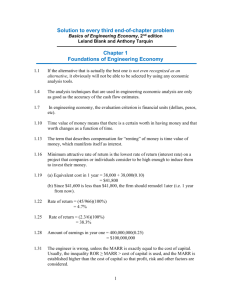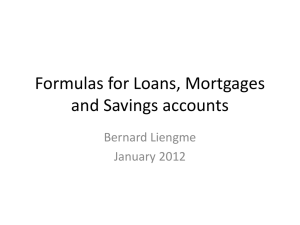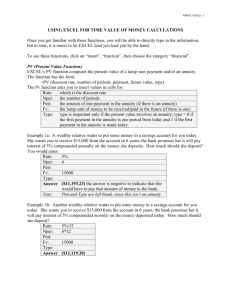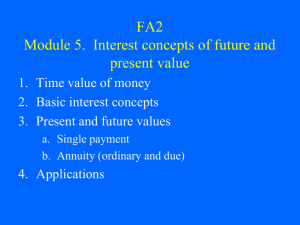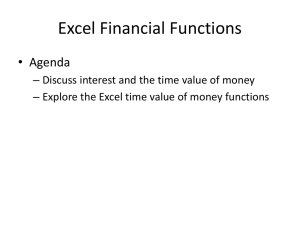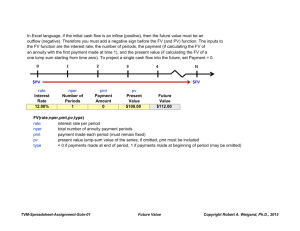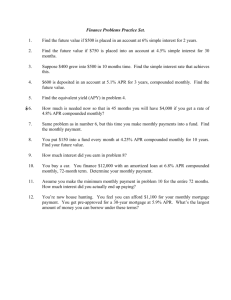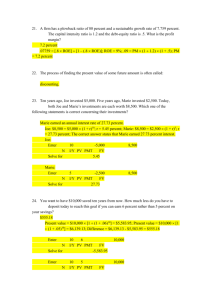SOLUTIONS TO CHAPTER 8 PROBLEMS
advertisement
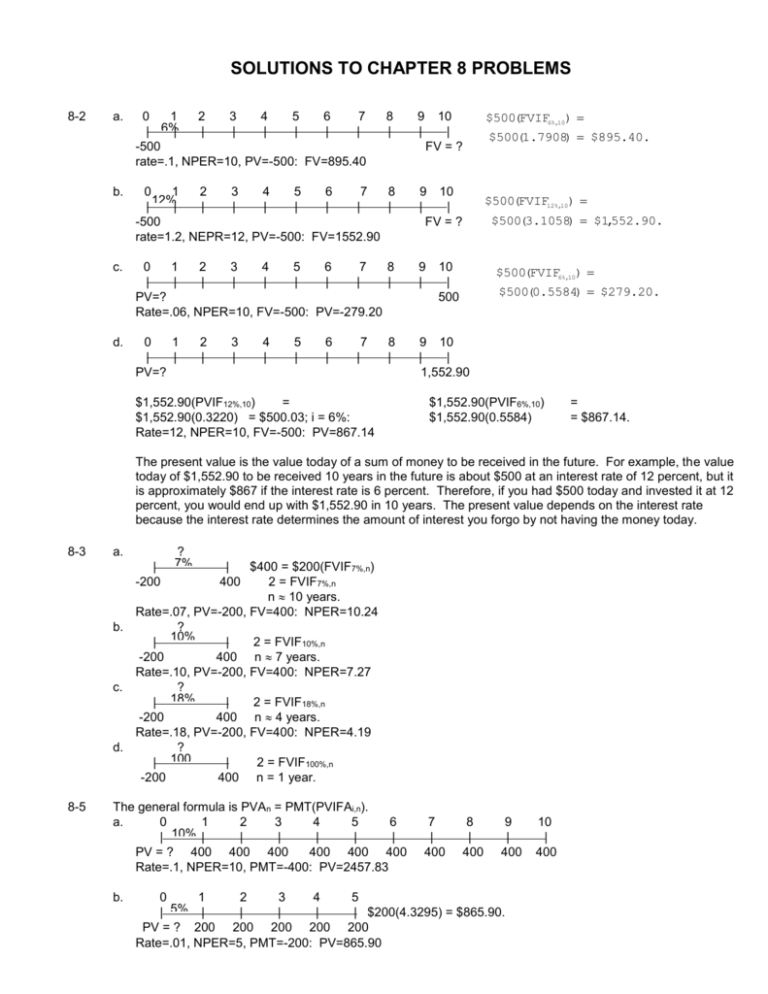
SOLUTIONS TO CHAPTER 8 PROBLEMS 8-2 a. b. c. d. 10 | FV = ? $500(FVIF6%,10) 0 1 2 3 4 5 6 7 8 12% | | | | | | | | | -500 rate=1.2, NEPR=12, PV=-500: FV=1552.90 9 10 | | FV = ? $500(FVIF12%,10) 0 1 2 3 4 5 6 7 8 | | | | | | | | | PV=? Rate=.06, NPER=10, FV=-500: PV=-279.20 9 | 0 1 | | PV=? 9 10 | | 1,552.90 0 1 2 3 4 5 6 7 | 6%| | | | | | | -500 rate=.1, NPER=10, PV=-500: FV=895.40 2 | 3 | 4 | 5 | 6 | 7 | 8 | 8 | $1,552.90(PVIF12%,10) = $1,552.90(0.3220) = $500.03; i = 6%: Rate=12, NPER=10, FV=-500: PV=867.14 9 | $500(1.7908) $895.40. $500(3.1058) $1,552.90. 10 | 500 $500(FVIF6%,10) $500(0.5584) $279.20. $1,552.90(PVIF6%,10) $1,552.90(0.5584) = = $867.14. The present value is the value today of a sum of money to be received in the future. For example, the value today of $1,552.90 to be received 10 years in the future is about $500 at an interest rate of 12 percent, but it is approximately $867 if the interest rate is 6 percent. Therefore, if you had $500 today and invested it at 12 percent, you would end up with $1,552.90 in 10 years. The present value depends on the interest rate because the interest rate determines the amount of interest you forgo by not having the money today. 8-3 a. | -200 ? 7% | $400 = $200(FVIF7%,n) 400 2 = FVIF7%,n n 10 years. Rate=.07, PV=-200, FV=400: NPER=10.24 b. ? | 10% | 2 = FVIF10%,n -200 400 n 7 years. Rate=.10, PV=-200, FV=400: NPER=7.27 c. ? | 18% | 2 = FVIF18%,n -200 400 n 4 years. Rate=.18, PV=-200, FV=400: NPER=4.19 d. ? | 100 | 2 = FVIF100%,n -200 % 400 n = 1 year. 8-5 The general formula is PVAn = PMT(PVIFAi,n). a. 0 1 2 3 4 5 6 | 10% | | | | | | PV = ? 400 400 400 400 400 400 Rate=.1, NPER=10, PMT=-400: PV=2457.83 b. 7 | 400 8 | 400 9 | 400 0 1 2 3 4 5 | 5% | | | | | $200(4.3295) = $865.90. PV = ? 200 200 200 200 200 Rate=.01, NPER=5, PMT=-200: PV=865.90 10 | 400 c. 0 1 | 0% | PV = ? 400 d. (1) 0 1 | 10% | 400 400 2 | 400 3 | 400 2 | 400 PV = ? PVAn (Annuity due) $400(6.1446)(1.10) (2) (3) 3 | 400 4 | 400 5 | $400(5) = $2,000.00. 400 4 | 400 5 | 400 6 | 400 7 | 400 8 | 400 9 | 400 10 | = PMT(PVIFAi,n)(1 + i). Therefore, = $2,703.62. 0 1 2 3 4 5 | 5% | | | | | 200 200 200 200 200 PVAn (Annuity due) = $200(4.3295)(1.05) = $909.20. 0 1 2 3 4 5 | 0% | | | | | 400 400 400 400 400 PV = ? PVAn (Annuity due)= $400(5)(1.00) = $2,200.00. Using Excel Work same as a-c except for type enter 1. 8-6 a. Cash Stream A Cash Stream B 0 1 2 3 4 5 0 1 2 3 4 5 | 8% | | | | | | 8% | | | | | PV = ? 100 400 400 400 300 PV = ? 300 400 400 400 100 A: Rate=.08, Value 1=100, Value 2=400, Value 3=400, Value 4=400, Value 5=300: NPER=1125.25 B: Rate=.08, Value 1=300, Value 2=400, Value 3=400, Value 4=400, Value 5=100: NPER=1300.32 b. PVA = $100 + $400 + $400 + $400 + $300 = $1,600. PVB = $300 + $400 + $400 + $400 + $100 = $1,600 8-7 These problems can all be solved using a financial calculator by entering the known values shown on the time lines and then pressing the I button. c. 0 10 i=? | | +85,000 -201,229 NPER=10, PV=-8500, FV=201299: rate=-.09 $201,229/$85,000 = 2.3674 = FVIFi,10; i = 9%. d. 0 1 i=? | | +9,000 -2,684.80 2 | -2,684.80 3 | -2,684.80 4 | -2,684.80 NPER=5, PMT=-2684.80, PV=9000: rate=.14999 8-8 a. 0 1 2 3 4 12% | | | | | -500 rate=.12, NPER=5, PV=-500: FV=881.15 5 | FV = ? Fvn = PV(1 + i)n = $500(1.12)5 = $500(1.7623) = $881.15. b. 0 1 2 3 4 5 6 7 8 9 10 6% | | | | | | | | | | | -500 FV = ? rate=-12/2=.06, NPER=2*5=10, PV=-500: FV=895.40 5 | -2,684.80 c. 0 4 8 12 16 20 | 3% | | | | | -500 FV = ? rate=12/4=.03, NPER=4*5=20, PV=-500: FV=903.05 8-9 a. 0 2 4 6 8 10 | 6% | | | | | PV = ? 500 rate=13/2=.06, NPER=5*2=10, FV=500: PV=-279.20 8-10 a. 0 | 6% 8-11 a. Universal Bank: Effective rate = 7%. 1 | 400 2 | 400 3 9 | | 400 400 FV = ? rate=.12/2=.06, NPER=10, PMT=-400: FV=5272.32 10 | 400 Regional Bank: rate=.06/4=.015, NPER=4, PV=-1: FV=1.0614 Effective rate=.0614 b. If funds must be left on deposit until the end of the compounding period (1 year for Universal and 1 quarter for Regional), and you think there is a high probability that you will make a withdrawal during the year, the Regional account might be preferable. For example, if the withdrawal is made after 10 months, you would earn nothing on the Universal account but (1.015)3 - 1.0 = 4.57% on the Regional account. Ten or more years ago, most banks and S&Ls were set up as described above, but now virtually all are computerized and pay interest from the day of deposit to the day of withdrawal, provided at least $1 is in the account at the end of the period. 8-12 a. With a financial calculator, enter N = 5, I = 10, PV = -25000, and FV = 0, and then press the PMT key to get PMT = $6,594.94. Then go through the amortization procedure as described in your calculator manual to get the entries for the amortization table. Year Payment 1 $ 6,594.94 2 6,594.94 3 6,594.94 4 6,594.94 5 6,594.93* $32,974.69 Repayment Remaining Interest of Principal Balance $2,500.00 $ 4,094.94 $20,905.06 2,090.51 4,504.43 16,400.63 1,640.06 4,954.88 11,445.75 1,144.58 5,450.36 5,995.39 599.54 5,995.39 0 $7,974.69 $25,000.00 *The last payment must be smaller to force the ending balance to zero. b. Here the loan size is doubled, so the payments also double in size to $13,189.87. c. 8-14 The annual payment on a $50,000, 10-year loan at 10 percent interest would be $8,137.27. Because the payments are spread out over a longer time period, more interest must be paid on the loan, which raises the amount of each payment. The total interest paid on the 10-year loan is $31,372.70 versus interest of $15,949.37 on the 5-year loan. a. First, determine the annual cost of college. The current cost is $12,500 per year, but that is escalating at a 5 percent inflation rate: College Current Years Inflation Cash Year Cost from Now Adjustment Required 1 $12,500 5 (1.05)5 $15,954 2 12,500 6 (1.05)6 16,751 3 12,500 7 (1.05)7 17,589 4 12,500 8 (1.05)8 18,468 rate= .05 NPER= PV= FV= 5 -12500 15954 6 16751 7 17589 8 18468 Now put these costs on a time line: 13 | 14 | 15 | 16 | 17 | 18 | -15,954 19 | -16,751 20 | -17,589 21 | -18,468 How much must be accumulated by age 18 to provide these payments at ages 18 through 21 if the funds are invested in an account paying 8 percent, compounded annually? $ 15,954 Rate=.08, NPER=1 $-16,751 NPER=2 $-17,589 NPER=3 $-18,468 PV=$15,954 PV=$ 15,510 PV=$ 15,079 PV=$ 14,660 $61,203 at age 18 Thus, the father must accumulate $61,203 by the time his daughter reaches age 18. b. She has $7,500 now (age 13) to help achieve that goal. Five years hence that $7,500, when invested at 8 percent, will be worth $11,020: rate=.08, NPER=5, PV=7500: FV=11020 c. The father needs to accumulate only $61,203 - $11,020 = $50,183. The key to completing the problem at this point is to realize the series of deposits represent an ordinary annuity rather than an annuity due, despite the fact the first payment is made at the beginning of the first year. The reason it is not an annuity due is there is no interest paid on the last payment which occurs when the daughter is 18. Thus, rate=.08, NPER=6, PV=-50183: PMT=6840.72 Another way to approach the problem is to treat the series of payments as a five-year annuity due with a lump sum deposit at the end of Year 5: $50,183 = FVADUE,5 + PMT = PMT[(PVIFA8%, 5)(1.08)] + PMT = PMT[5.8666(1.08) + 1]. Therefore, PMT = $50,183/7.3353 = $6,841. 8-15 0 1 | 14% | PV = ? 2 | 3 | 2,000 4 | 5 | 6 | rate=.14, NPER=6, FV=-2000: PV=911.20 $1,000 today is worth more. The present value of $2,000 at 14 percent over six years is $911.20, which is less than $1,000.00. Alternatively, the future value of $1,000 is: FV6 = $1,000(1.14)6 = $1,000(2.1950) = $2,195. 8-16 a. 1997 1998 1999 2000 2001 | ? | | | | -6 NPER=5, PV=-6, FV=12: Rate=.1487 2002 | 12 (in millions) b. The calculation described in the quotation fails to take account of the compounding effect. It can be demonstrated to be incorrect as follows: $6,000,000(1.20)5 = $6,000,000(2.4883) = $14,929,800, which is greater than $12 million. Thus, the annual growth rate is less than 20 percent; in fact, it is about 15 percent, as shown in Part a. 8-18 0 |i = ? -13,250 1 | 2,345.05 2 | 2,345.05 3 | 2,345.05 4 | 2,345.05 5 | 2,345.05 6 | 7 | 2,345.05 2,345.05 8 | 2,345.05 9 | 10 | 2,345.05 2,345.05 NPER=10, PV=-13,250, PMT=2345.05: Rate=.12 With a calculator, enter N = 10, PV = -13250, PMT = 2345.05, FV = 0, and then solve for I = 12%. 8-19 0 1 | i=? | 85,000 -8,273.59 2 | -8,273.59 3 | -8,273.59 4 | -8,273.59 30 | -8,273.59 NPER=30, PV=8,5000, PMT=8273.59: Rate=.09 8-21 0 1 | 9% | 12,000 -1,500 2 | -1,500 ? | -1,500 rate=.09, PV=12000, PMT=-1500: NPER=14.77 8-22 0 | 12% 1 | 2 | 3 | 1,250 1,250 4 | 1,250 1,250 FV = 10,000 5 | 6 | 1,250 ? Using Excel, get a "ballpark" estimate of the years by entering rate=.1, FV = 10000, PMT = -1250, then NPER = 5.94 years. This answer assumes that a payment of $1,250 will be made 94/100th of the way through Year 5. Now find the FV of $1,250 for 5 years at 12%; it is $7,941.06. Compound this value for 1 year at 12% to obtain the value in the account after 6 years and before the last payment is made; it is $7,941.06(1.12) = $8,893.99. Thus, you will have to make a payment of $10,000 - $8,893.99 = $1,106.01 at Year 6, so the answer is: it will take 6 years, and $1,106.01 is the amount of the last payment. 8-26 First, find PMT by using a financial calculator: N = 5, I/YR = 15, PV = -1000000, and FV = 0. Solve for PMT = $298,315.55. Then set up the amortization table: Beginning Ending Year Balance Payment Interest Principal Balance 1 $1,000,000.00 $298,315.55 $150,000.00 $148,315.55 $851,684.45 2 851,684.45 298,315.55 127,752.67 170,562.88 681,121.57 8-28 Fraction that is principal = $170,562.88/$298,315.55 = 0.5718 = 57.18%. Here we want to have the same effective annual rate on the credit extended as on the bank loan that will be used to finance the credit extension. First, we must find the EAR = EFF% on the bank loan. Enter NOM% = 15, N = P/YR = 12, and press EFF% to get EAR = 16.08%. Now recognize that giving 3 months of credit is equivalent to quarterly compounding--interest is earned at the end of the quarter, so it is available to earn interest during the next quarter. Therefore, enter P/YR = 4, EFF% = EAR = 16.08%, and press NOM% to find the nominal rate of 15.19 percent. Therefore, if a 15.19 percent nominal rate is charged and credit is given for 3 months, the cost of the bank loan will be covered. Alternative solution: We need to find the effective annual rate (EAR) the bank is charging first. Then, we can use this EAR to calculate the nominal rate that should be quoted to the customers. Bank EAR: EAR = (1 + iNom/m)m - 1 = (1 + 0.15/12)12 - 1 = 16.08%. Nominal rate that should be quoted to customers: 16.08% 1.1608 1.0380 iNom = (1 + iNom/4)4 - 1 = (1 + iNom/4)4 = 1 + iNom/4 = 0.0380(4) = 15.19%.
